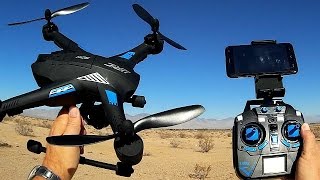4DRC V2 Mini Drone for Kids Beginners, RC Foldable Nano Drone Pocket Quadcopter for Boys and Grils Toys with Altitude Hold, Headless Mode, 3D Flips, One Key Return and Speed Adjustment and 3 Batteries
4DRC V4 Foldable Drone with 1080p HD Camera for Adults and Kids, Quadcopter with Wide Angle FPV Live Video, Trajectory Flight, App Control, Optical Flow, Altitude Hold and 2 Modular Batteries
ATTOP Drone for Kids Drones with Camera for Kids & Beginners, AR Game Mode RC Mini Drone wApp Gravity Voice Control Trajectory Flight Altitude Hold 360°Flip Kids Drone Foldable & Portable
DJI Mavic Mini Drone FlyCam Quadcopter UAV with 2.7K Camera 3 Axis Gimbal GPS 30 min Flight Time, less than 0.55 lbs
Drones with 1080P HD Camera for Beginners, JJRC H71 Foldable Drone with Optical Flow Positioning, FPV WiFi Live Video Quadcopter for Adults, 22 mins Long Flight Time Rc Drone with 2 Batteries
Force1 Mini Drone with Camera U34W Dragonfly FPV Drones for Beginners, Indoor Drone, and Small Drone with Camera WiFi Flying & VR Capability
Holy Stone HS720 Foldable GPS Drone with 4K UHD Camera for Adults, Quadcopter with Brushless Motor, Auto Return Home, Follow Me, 26 Minutes Flight Time, Long Control Range, Includes Carrying Bag
NEW DJI Mavic Air 2 Fly More Combo Drone Quadcopter UAV with 48MP Camera 4K Video 12 CMOS Sensor 3-Axis Gimbal 34 min Flight Time Active Track 3.0, Grey
Potensic A30W FPV Drone with Camera, Mini RC Nano Quadcopter with Camera, Auto Hovering, Route Setting, Gravity Induction Mode and 500 mAh Detachable Battery
SNAPTAIN A15H Foldable FPV WiFi Drone wVoice Control120 degree Wide Angle 720P HD Camera Trajectory Flight Altitude HoldG Sensor 3D Flips Headless ModeOne Key Return 2 Modular Batteries App Control
________________
An unmanned aerial vehicle (UAV) (or uncrewed aerial vehicle, commonly known as a drone) is an aircraft without a human pilot on board and a type of unmanned vehicle. UAVs are a component of an unmanned aircraft system (UAS); which include a UAV, a ground-based controller, and a system of communications between the two. The flight of UAVs may operate with various degrees of autonomy: either under remote control by a human operator, autonomously by onboard computers or piloted by an autonomous robot.
Compared to crewed aircraft, UAVs were originally used for missions too “dull, dirty or dangerous” for humans. While they originated mostly in military applications, their use is rapidly expanding to commercial, scientific, recreational, agricultural, and other applications, such as policing and surveillance, product deliveries, aerial photography, infrastructure inspections, smuggling, and drone racing. Civilian UAVs now vastly outnumber military UAVs, with estimates of over a million sold by 2015.
Recreational use
From 21 December 2015, all hobby type UAVs between 250 grams and 25 kilograms needed to be registered with FAA no later than 19 February 2016.
The new FAA UAV registration process includes requirements for:
Eligible owners must register their UAVs prior to flight. Non-commercial flights are no longer subject to registration.
If the owner is less than 13 years old, a parent or other responsible person must do the FAA registration.
UAVs must be marked with the FAA-issued registration number.
The registration fee is $5. The registration is good for 3 years and can be renewed for an additional 3 years at the $5 rate.
A single registration applies to all UAVs owned by an individual. Failure to register can result in civil penalties of up to $27,500 and criminal penalties of up to $250,000 and/or imprisonment for up to three years.
On 19 May 2017, in the case Taylor v. Huerta, the U.S. Court of Appeals for the District of Columbia Circuit held that the FAA’s 2015 drone registration rules were in violation of the 2012 FAA Modernization and Reform Act. Under the court’s holding, although commercial drone operators are required to register, recreational operators are not. On 25 May 2017, one week after the Taylor decision, Senator Dianne Feinstein introduced S. 1272, the Drone Federalism Act of 2017, in Congress.
Commercial use
On 21 June 2016, the Federal Aviation Administration announced regulations for commercial operation of small UAS craft (sUAS), those between 0.55 and 55 pounds (about 250 gm to 25 kg) including payload. The rules, which exclude hobbyists, require the presence at all operations of a licensed Remote Pilot in Command. Certification of this position, available to any citizen at least 16 years of age, is obtained solely by passing a written test and then submitting an application. For those holding a sport pilot license or higher, and with a current flight review, a rule-specific exam can be taken at no charge online at the faasafety.gov website. Other applicants must take a more comprehensive examination at an aeronautical testing center. All licensees are required to take a review course every two years.







 ? Martinez FARM ???
? Martinez FARM ???